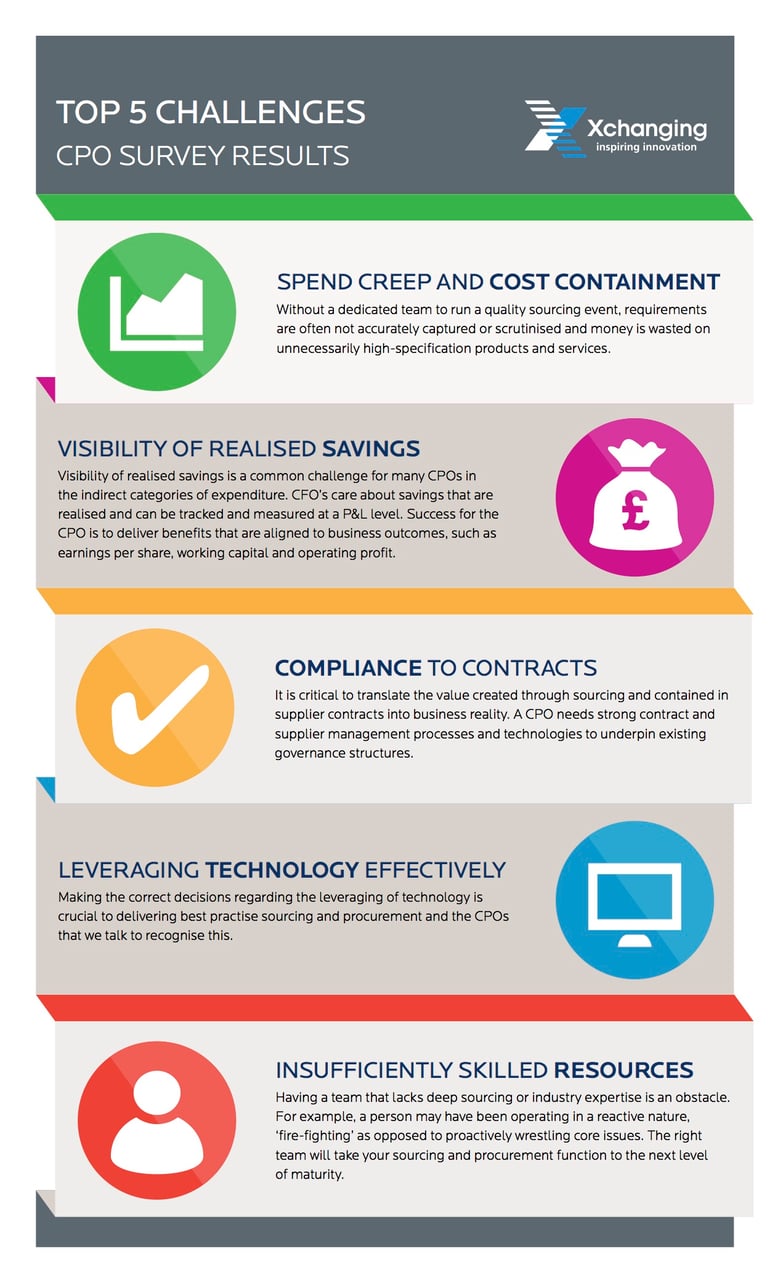Steve Trainor, the Managing Director of Xchanging, a procurement outsourcing provider recently did a survey of CPOs across the world.
In the process, he found that “reducing spend with third-party suppliers, driving down the cost of procurement, managing supply-led risk and harnessing true innovation from the supply base remain the most significant business objectives that the CPO must address.”
He also detailed five other challenges that procurement managers commonly come up against, which I’ve outlined below.

Spend Creep and Cost Containment
Without a dedicated team to run quality sourcing from end-to-end, internal product requirements are often not accurately captured or scrutinized. As a result, money is wasted on unnecessarily high-specification products and services.
It takes a good amount of time to truly understand the needs of the project and understand where and if costs can be cut. For example, does your spec say 55 gallon drums simply because it’s what you’ve always gotten? Could you use larger packaging sizes to save money? Making sure that costs don’t slowly rise over time or that you’re not using specs that are too “premium” and costly can take much time from a dedicated team.
In addition, you may loose money if you don’t have team members making sure that contracts are adhered to and that budgets are not being pushed further and further each day. You’ll need to make sure that, once a contract is confirmed, suppliers are adhering to it.
You’ll also need to have the people, process and technology to measure and track your current spend. It’ll be important to make sure that there isn’t an “overspend lag”, meaning that by the time anyone notices spend is going over budget, it’s already too late.
Visibility of Realized Savings
Another common challenge for CPOs is the ability to track and show realized savings in the indirect categories of expenditure.
Most CFO’s care about saving that can be tracked, measured and documented. If they can’t be measured, they don’t exist! Right? Well, you know this isn’t always the case.
However, success for the CPO requires delivering benefits that are aligned with business outcomes (like earnings per share, working capital and operating profit) and showing those measurable results. Only when the savings can be measured and audited in this way can the procurement function really become a fundamental part of the business performance planning process.
Compliance To Contracts
Once you analyze your needs and agree upon a contract, it’s important to follow through to make sure that this contract is translated into value created for the business over time. To do this, you’ll need to make sure that the supplier is sticking to your contract.
On the flip side, you’ll need to make sure that your team is taking advantage of the value that this supplier that provides to your business. It’s a common frustration for CPO’s to find that contracts are not being taken advantage of to the full extent that they could be — not only is this lost savings, but it also dilute’s your company’s long term “buying power” in the market.
Don’t work hard to put a valuable contract into place and then see it ignored by either party.
Leveraging Technology Effectively
Leveraging the right technology is crucial to delivering the best sourcing and procurement possible.
Procurement technology has come a long way in recent years. There’s now technology for spend analytics, eSourcing, Supplier & Contract Management, eWorkflow, spot buying/tail spend management, savings tracking and budget management, just to name a few.
This technology, coupled with market intelligence and data can make your procurement process more informed, efficient, and effective. These tools can also help you accurately track your savings and other measurables your CFO wants to see.
The challenge for most CPOs is finding and justifying the up-front capital to invest in these technologies, so that in the long run they can better enable cost reduction.
Insufficiently Skilled Resources
Having a team that lacks sourcing and industry expertise can be a huge challenge. For example, many CPOs struggle with team members who constantly put out small fires rather than taking a step back and trying to solve the deeper core problem.
Of course, being able to do this requires a few key skills of any leader. Resourcefulness and grit (two traits that will help your team members forge a new way and figure out how to get it done) are extremely helpful. (These traits are part of 5 intangible traits that make great leaders).
Work hard to cultivate a team that is proactive, resourceful and experienced in procurement.
If they don’t come to you that way, think about what can you do to help train them and provide opportunities for growth.
What are the biggest challenges that you’ve encountered in your procurement? Tell us in the comments below.
Topics: Purchasing & Procurement












